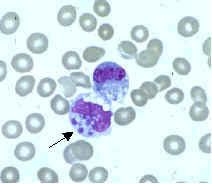ICD-9-CM 082.41 MedlinePlus 001381 MeSH D016873 | DiseasesDB 31131 eMedicine med/3391 | |
 | ||
Human monocytotropic ehrlichiosis (HME) is a form of ehrlichiosis associated with Ehrlichia chaffeensis.This bacteria is an obligate intracellular pathogen affecting monocytes and macrophages.
Contents
Symptoms
The most common symptoms are fever, headache, malaise, and muscle aches (myalgia). Compared to human granulocytic ehrlichiosis, rash is more common. Laboratory abnormalities include thrombocytopenia, leukopenia, and elevated liver tests.
The severity of the illness can range from minor or asymptomatic to life-threatening. CNS involvement may occur. A serious septic or toxic shock-like picture can also develop, especially in patients with impaired immunity.
Diagnosis
Tick exposure is often overlooked. For patients living in high-prevalence areas who spend time outdoors, a high degree of clinical suspicion should be employed.
Ehrlichia serologies can be negative in the acute period. PCR is therefore the laboratory diagnostic tool of choice.
Treatment
If ehrlichiosis is suspected, treatment should not be delayed while waiting for a definitive laboratory confirmation, as prompt doxycycline therapy has been associated with improved outcomes. Doxycycline is the treatment of choice.
Presentation during early pregnancy can complicate treatment.Rifampin has been used in pregnancy and in patients allergic to doxycycline.
Epidemiology
In the USA, HME occurs across the south-central, southeastern, and mid-Atlantic states, regions where both the white-tailed deer (Odocoileus virginianus) and lone star ticks (Amblyomma americanum) thrive.
HME occurs in California in Ixodes pacificus ticks and in Dermacentor variabilis ticks.Nearly 600 cases were reported to the CDC in 2006. In 2001–2002, the incidence was highest in Missouri, Tennessee, and Oklahoma, as well as in people older than 60.
